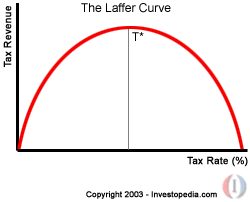
What is it? Basically, it shows the relationship to the income tax rate (marginal) and how much money a government can expect to raise. Raise the tax rate too high, and you begin to fall on the downward slope - the laws of diminishing returns and unintended consequences. The higher you raise taxes, the less incentive there is for people to work that extra hour over their minimum requirement ("why should I? The government is just going to take most of it"). Additionally, those in the upper brackets then find it optimal to seek evasive shelters and schemes to lower their taxes. For them, it makes sense to spend almost $600,000 to shield $1m of income to save $600,000 in taxes on that income (assuming a 60% marginal tax rate). Thus, the goverment loses money.
As an historical note, prior to the Reagan tax cuts of '82, the uber-rich rarely paid taxes. Real estate tax shelters provided huge shelters for income and the government lost taxes. Cutting taxes in 1981 added nearly 21 million jobs over 8 years; those additional workers expanded the economy, thereby funding massive defense spending increases.
Currently, the marginal tax rate stands at 36%. However, Russia and the Baltic states that have recently instituted a lower than 35% flat tax rate experienced massive growth immediately. Thus, a reasonable reduction in the top marginal tax rate could generate increased GNP growth similiar to the newly developed deomcracies of Eastern Europe.
For additional analysis of the historical impact of lowering taxes and the applicability of the Laffer Curve, see the Heritage Foundation's excellent analysis on the three eras of marginal rate reductions in the United States.
No comments:
Post a Comment